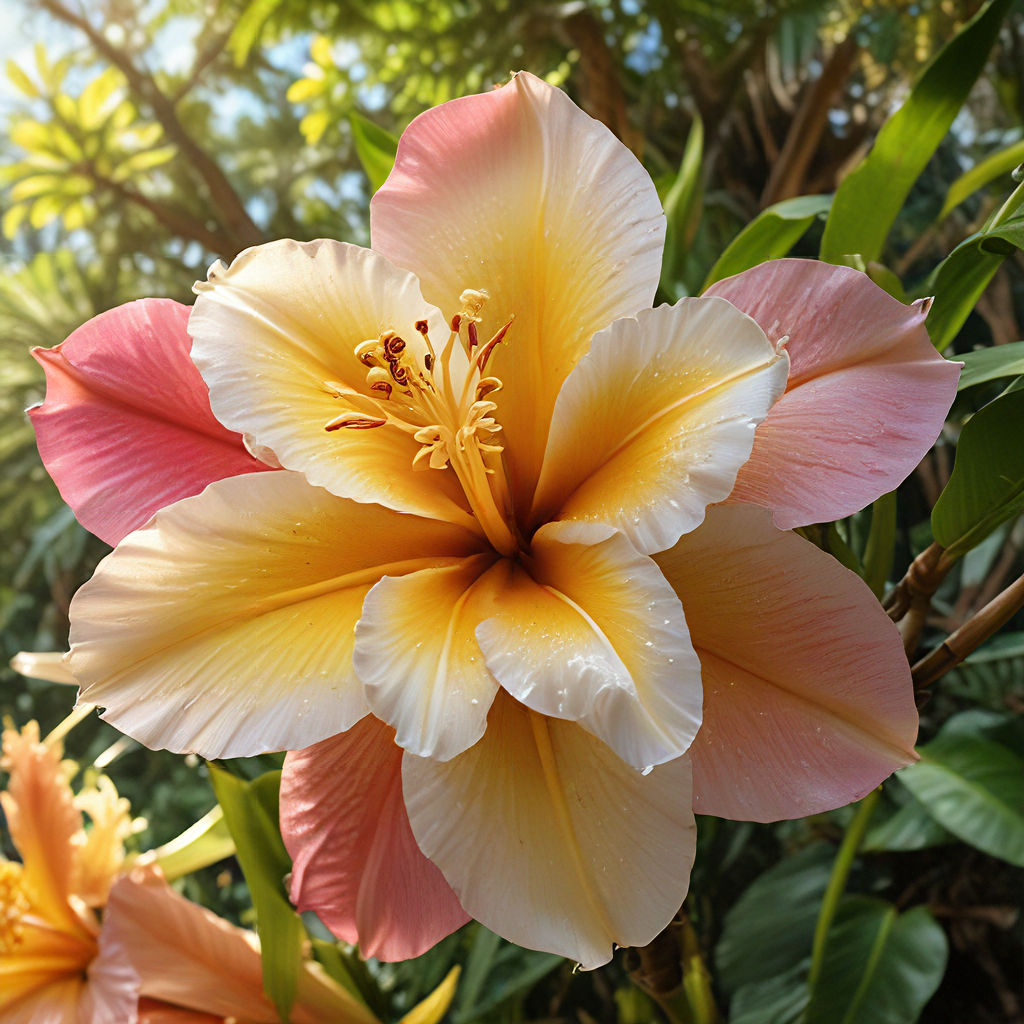The Naupaka Flower: A Symbol of Separated Love
In the lush landscapes of the Hawaiian Islands, where nature's beauty weaves intricate tales, there blooms a unique and captivating flower known as the Naupaka. More than just a pretty blossom, the Naupaka holds a profound significance in Hawaiian legends, symbolizing the bittersweet nature of love and loss. The flower's distinctive shape and the stories surrounding its origin have captivated the hearts of Hawaiians for generations, making it an enduring emblem of separation and longing.
The Legend of the Naupaka Flower
The tale of the Naupaka flower is often told as a poignant story of star-crossed lovers separated by fate. The legend narrates the tragic romance of a young couple who were deeply in love but forbidden to be together. Their families were bitter rivals, determined to keep them apart. The heartbroken lovers met secretly, finding solace in each other's company amidst the lush tropical vegetation.
The Myth of the Star-Crossed Lovers
As the lovers' clandestine meetings continued, they began to fear the consequences of their actions. They knew that if their love was discovered, their families would punish them harshly. Determined to find a way to be together, they sought guidance from the gods. In response to their plea, the gods decided to transform the lovers into a beautiful flower, but with a twist.
The Naupaka’s Transformation
The gods, moved by the couple's unwavering love, decided to transform them into a flower that would forever symbolize their devotion. They turned the young woman into the upper half of the flower, with its delicate white petals, while the man became the lower half, consisting of green leaves. By separating the two halves of the flower, the gods created a powerful symbol of the lovers' tragic fate.
The Naupaka’s Distinctive Shape
The Naupaka flower is easily recognized by its unique form. It appears as a half-circle, with only one half present, either the upper (petals) or lower (leaves). This incomplete shape reflects the legend of the separated lovers and is the source of its key symbolism. The missing half suggests the other half of their love, eternally absent.
The Naupaka’s Distinctive Shape
The Naupaka flower's unique half-circle shape is a key element in its symbolism. The upper half, with its delicate white petals, is often called the "female" part of the flower. The lower half, with its green leaves, is referred to as the "male" part. The missing half of the flower suggests a sense of incompleteness, a longing for what is missing. It is a constant reminder of the love that was tragically separated.
Symbolism of the Incomplete Half
The incomplete nature of the Naupaka flower is central to its meaning. It represents the lack of wholeness, the feeling of being incomplete without the other half. The missing half of the flower symbolizes the absence of the loved one, the yearning for their presence. This symbolism resonates deeply with the legend of the star-crossed lovers, forever separated but eternally connected through the flower's enduring beauty.
Representing Separation and Longing
The Naupaka, in its incomplete form, serves as a reminder of the pain of separation and the enduring power of longing. It echoes the universal human experience of loss, reminding us of the powerful emotions that come with love and separation. The flower's symbolic meaning transcends the specific legend, resonating with anyone who has ever felt the pang of unrequited love or the grief of loss.
Naupaka in Hawaiian Culture and Tradition
Beyond its symbolic significance, the Naupaka flower holds a special place in Hawaiian culture and tradition. The flower's beauty and symbolism make it a cherished part of everyday life and traditional ceremonies.
Use in Lei Making
The Naupaka flower is often used in the creation of traditional Hawaiian leis. The flower's delicate white petals and green leaves make it a visually appealing addition to the colorful leis, enhancing their beauty and adding a layer of symbolic meaning. The presence of a Naupaka flower in a lei often suggests a deep connection to love, loss, and the enduring power of memory.
Offering to the Gods
In traditional Hawaiian ceremonies, the Naupaka flower was often offered to the gods as a symbol of respect and devotion. The flower's symbolism of love and longing made it an appropriate offering to the gods, seeking their guidance and intervention in matters of the heart. It was a way to connect with the divine and seek solace in times of sorrow and separation.
The Naupaka as a Reminder of Love and Loss
The Naupaka flower holds a special place in the hearts of Hawaiians. Its symbolism of longing and separation serves as a reminder of the bittersweet nature of love. The flower's presence evokes a sense of nostalgia, reminding people of the loved ones they have lost and the memories they cherish.
The Flower’s Enduring Significance
The Naupaka flower continues to be a powerful reminder of love and loss, its symbolism echoing across generations. It serves as a reminder that even in the midst of sorrow and separation, love can endure in the form of memory and the enduring power of the human spirit.
Connecting with Hawaiian Heritage
The Naupaka flower plays a vital role in connecting people with their Hawaiian heritage. The flower's symbolism and its use in traditional ceremonies serve as a reminder of the rich culture and traditions that have shaped the Hawaiian people. The Naupaka serves as a link to the past, reminding people of their ancestors and the stories that have been passed down through generations.
Theories on the Naupaka Symbolism
While the legend of the star-crossed lovers is widely accepted as the origin of the Naupaka's symbolism, there are also other interpretations of the flower's meaning. Some theories suggest that the flower symbolizes the separation of land and sea, representing the duality of nature. Others believe it represents the duality of the human spirit, with its capacity for both joy and sorrow.
Interpretations of the Myth
The beauty of the Naupaka myth lies in its openness to interpretation. The story allows each individual to connect with the symbolism at a personal level, finding meaning that resonates with their own experiences and beliefs. The flower's enduring power lies in its ability to speak to the universal human experience of love, loss, and the complexities of the human heart.
Evolution of the Symbolism
Throughout the years, the symbolism of the Naupaka flower has evolved. The flower's meaning has been shaped by the experiences and interpretations of generations of Hawaiians, reflecting the changing dynamics of society and the ever-evolving nature of human emotions. Despite this evolution, the Naupaka continues to resonate with its core symbolism, reminding people of the enduring power of love, the pain of separation, and the importance of cherishing memories.
The Naupaka’s Enduring Power
The Naupaka flower remains a powerful symbol in Hawaiian culture. It serves as a reminder of love, loss, and the enduring nature of the human spirit. The flower's presence evokes a sense of nostalgia, reminding people of their ancestors, their cultural heritage, and the stories that have shaped their lives. Its symbolism continues to resonate with people of all backgrounds, transcending cultural and geographical boundaries.
A Timeless Symbol of Love and Loss
The Naupaka flower remains a timeless symbol of love and loss. The flower's enduring significance lies in its ability to connect with the universal human experience of love, separation, and the enduring power of memory. The Naupaka serves as a reminder of the bittersweet nature of life and the beauty that can be found even in the midst of sorrow and loss.
The Flower’s Continued Presence in Hawaiian Art and Literature
The Naupaka flower continues to be a popular subject in Hawaiian art and literature. The flower's symbolism and its association with love, loss, and the beauty of the natural world make it a captivating subject for artists and writers, inspiring them to create works that evoke emotion and connect with the human spirit. The Naupaka flower is a reminder of the powerful connection between nature, culture, and the human experience, serving as a source of inspiration for generations to come.
FAQ
Q: What is the legend of the Naupaka flower?
A: The legend tells the story of two lovers who were forbidden to be together due to their families' rivalry. The gods, moved by their devotion, transformed them into a flower, separating the upper and lower parts to symbolize their tragic fate.
Q: What does the Naupaka flower symbolize?
A: The Naupaka flower symbolizes love, longing, and separation. Its incomplete shape represents the absence of the loved one and the yearning for their presence.
Q: Why is the Naupaka flower important in Hawaiian culture?
A: The Naupaka flower holds a special place in Hawaiian culture. It is used in traditional leis, offered to the gods, and serves as a reminder of love, loss, and the enduring nature of the human spirit.
Q: What other interpretations are there of the Naupaka flower's symbolism?
A: Some believe the flower symbolizes the separation of land and sea, while others see it as representing the duality of the human spirit.
Q: How is the Naupaka flower used in Hawaiian art and literature?
A: The Naupaka flower is a popular subject in Hawaiian art and literature, inspiring artists and writers to create works that evoke emotion and connect with the human experience.



